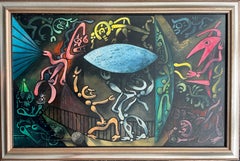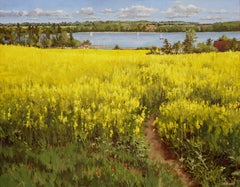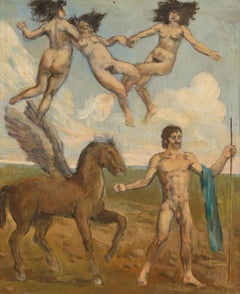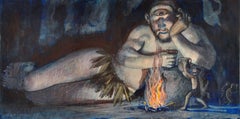Tempera Figurative Paintings
1990s Byzantine Tempera Figurative Paintings
Silver
1940s American Modern Tempera Figurative Paintings
Masonite, Oil, Tempera
1930s American Impressionist Tempera Figurative Paintings
Masonite, Tempera
2010s Realist Tempera Figurative Paintings
Egg Tempera, Canvas
1970s Expressionist Tempera Figurative Paintings
Tempera, Cardboard
Early 2000s Contemporary Tempera Figurative Paintings
Egg Tempera, Panel
15th Century and Earlier Old Masters Tempera Figurative Paintings
Oil, Tempera, Wood Panel
1940s American Modern Tempera Figurative Paintings
Tempera, Board
2010s Realist Tempera Figurative Paintings
Oil, Tempera, Wood Panel
2010s Byzantine Tempera Figurative Paintings
Gold Leaf
Late 20th Century American Realist Tempera Figurative Paintings
Paper, Casein
2010s Contemporary Tempera Figurative Paintings
Canvas, Tempera
Mid-20th Century Modern Tempera Figurative Paintings
Mixed Media, Tempera, Watercolor
21st Century and Contemporary Contemporary Tempera Figurative Paintings
Egg Tempera, Panel
1990s Abstract Expressionist Tempera Figurative Paintings
Pastel, Tempera, Cardboard
21st Century and Contemporary Contemporary Tempera Figurative Paintings
Egg Tempera, Panel
1990s Outsider Art Tempera Figurative Paintings
Mirror, Plaster, Casein, Wood Panel
1860s Victorian Tempera Figurative Paintings
Ink, Egg Tempera
1990s Surrealist Tempera Figurative Paintings
Tempera
1940s Tempera Figurative Paintings
Tempera, Gouache
Early 20th Century Modern Tempera Figurative Paintings
Paper, Tempera
2010s Realist Tempera Figurative Paintings
Gold Leaf
21st Century and Contemporary Renaissance Tempera Figurative Paintings
Gold Leaf
1930s Modern Tempera Figurative Paintings
Tempera
2010s Realist Tempera Figurative Paintings
Silver, Gold Leaf
2010s Conceptual Tempera Figurative Paintings
Canvas, Acrylic, Tempera
2010s Contemporary Tempera Figurative Paintings
Gold Leaf
2010s Modern Tempera Figurative Paintings
Mixed Media, Tempera, Board
2010s Realist Tempera Figurative Paintings
Gold Leaf
19th Century Other Art Style Tempera Figurative Paintings
Ink, Tempera, Laid Paper
Late 19th Century Romantic Tempera Figurative Paintings
Tempera, Paper
19th Century Other Art Style Tempera Figurative Paintings
Paper, Ink, Tempera
1990s Byzantine Tempera Figurative Paintings
Gold Leaf
15th Century and Earlier Old Masters Tempera Figurative Paintings
Tempera, Wood Panel
Early 2000s Abstract Expressionist Tempera Figurative Paintings
Tempera
1940s American Modern Tempera Figurative Paintings
Masonite, Oil, Tempera
2010s Realist Tempera Figurative Paintings
Gold Leaf, Silver
18th Century Medieval Tempera Figurative Paintings
Egg Tempera
19th Century Other Art Style Tempera Figurative Paintings
Ink, Tempera, Laid Paper
15th Century and Earlier Old Masters Tempera Figurative Paintings
Panel, Tempera
21st Century and Contemporary Contemporary Tempera Figurative Paintings
Canvas, Linen, Tempera
1990s Contemporary Tempera Figurative Paintings
Mixed Media, Ink, Tempera, Watercolor
2010s Contemporary Tempera Figurative Paintings
Canvas, Tempera, Ink
1960s Post-Impressionist Tempera Figurative Paintings
Casein
2010s Realist Tempera Figurative Paintings
Gold Leaf
1930s Modern Tempera Figurative Paintings
Linen, Egg Tempera
2010s Realist Tempera Figurative Paintings
Egg Tempera, Canvas
1930s Abstract Expressionist Tempera Figurative Paintings
Tempera, Casein, Canvas
2010s Conceptual Tempera Figurative Paintings
Color Pencil, Tempera, Permanent Marker
2010s Contemporary Tempera Figurative Paintings
Tempera, Archival Paper
2010s Realist Tempera Figurative Paintings
Egg Tempera, Canvas
1940s American Modern Tempera Figurative Paintings
Masonite, Oil, Tempera
1960s Art Nouveau Tempera Figurative Paintings
Tempera, Illustration Board
2010s Realist Tempera Figurative Paintings
Oil, Tempera, Wood Panel
1940s Academic Tempera Figurative Paintings
Tempera
2010s Realist Tempera Figurative Paintings
Gold Leaf
2010s Realist Tempera Figurative Paintings
Gold Leaf
20th Century Tempera Figurative Paintings
Tempera, Board
2010s Contemporary Tempera Figurative Paintings
Birch, Egg Tempera
1930s Art Deco Tempera Figurative Paintings
Tempera
Tempera figurative paintings for sale on 1stDibs.
Read More
See Kent Monkman’s Magical Realist Take on Frontier History
With a solo show at the Denver Art Museum and a commission from the Met, the Cree Canadian painter has become an international sensation.
Cecilia Vicuña Merges Politics, Science and Spirituality in Her Poetic Art
The Chilean creator, who has been living in exile in New York for decades, is having a major moment, receiving the biggest exhibitions, commissions and awards an artist could dream of.




